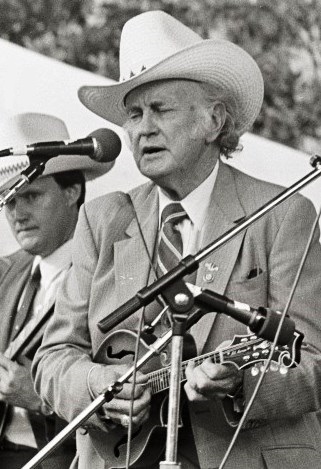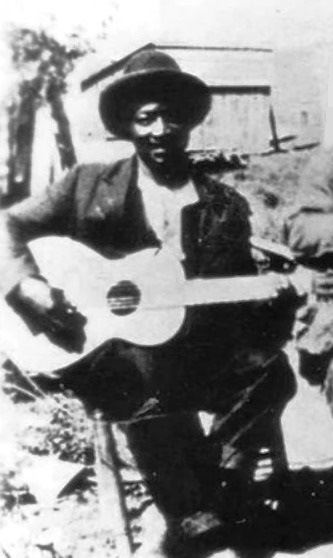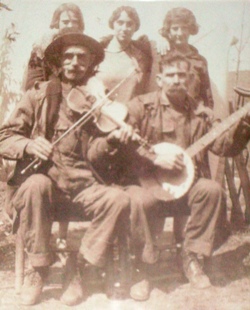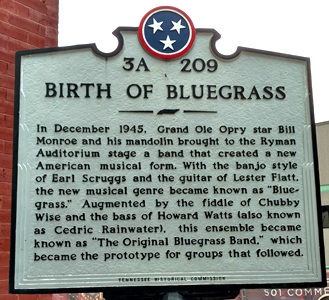Kirk Seace
(bio pending)
Matthew P. Tessier
Matt Tessier, a lifelong Louisiana resident, has been involved in the bluegrass music community as a banjo player and vintage instrument collector for the past 20 years. Like many others, Matt started learning music on the piano at age six but became a banjo player at age 10 after discovering the music of Earl Scruggs. He has played with many local bands during his lifetime and was featured in the award-winning 2011 documentary short film Fanning the Fire produced by the Bluegrass Heritage Foundation. Matt has worked with the Foundation on nearly all its events as a stage and artist accommodation manager since 2013.
For the past five years Matt has worked for Cavender’s Boot City, based in Tyler, Texas, and presently manages their store in Shreveport, Louisiana. He is an avid watch collector who founded a Facebook group called the Accutron Collectors in 2017. The group has grown to a membership of 1500 and is now the largest Accutron-specific organization in the world.
Raleigh W. Newsam
Raleigh Newsam is an attorney in Dallas, Texas, where he practices construction, real estate, and intellectual property law. He earned an architecture degree from Cornell University, a master’s degree in management degree from MIT, and a law degree from Southern Methodist University. Born in New York City, he spent his youth in Long Island, New York and Clarksville, Tennessee. It was in Clarksville that he developed his love and enthusiasm for bluegrass and country music. Raleigh has been active with numerous charitable organizations in the north Texas area and is a former President of Dallas Christian Leadership.
Charlie R. Seraphin
Charlie Seraphin has lived and worked in nine states and two foreign countries. Professionally, he managed radio news operations in five cities including Miami and San Francisco. He served as VP/General Manager of top-rated radio stations in Los Angeles, San Diego, and Dallas. He spent 15 years in professional sports as chief marketing officer for the Texas Rangers and Kansas City Royals of Major League Baseball, as Executive VP/General Manager of the Tulsa 66ers, and as Senior VP of Sales and Marketing for Hunt Sports Group in Dallas. Charlie also served three years as an adjunct professor at Flagler College in St. Augustine, Florida.
Charlie is now an author and guest speaker based in Payson, Arizona. His message is simple and direct, with strong emphasis on reflection and personal responsibility. His recent book, One Stupid Mistake–Smart Decision-Making in a Crazy World, is drawn from personal experience with roots in common sense. His favorite keynote speech to deliver is Making Good Decisions in a Crazy World, which outlines a simple formula for personal responsibility and success. For more about Charlie, see CharlieSeraphin.com.
A Brief History of Bluegrass Music

William Smith “Bill” Monroe
The origin of bluegrass music can be traced to the people who came to America in the 1600s from Ireland, Scotland, and England and brought with them basic styles of music that are generally considered to be the roots of modern bluegrass music. As the settlers began to move out into North and South Carolina, Tennessee, Kentucky, Virginia, and West Virginia, they wrote songs about daily life in the new land. Since most of these people lived in remote areas, many of the songs reflected life on the farm or in the hills. This music was often referred to as country, hillbilly, or mountain music. Its development included the blending of elements from gospel music and the blues music that was prominent among people of African origin who lived in the Mississippi Delta region. The invention of the phonograph and the onset of radio in the early-to-mid 1900s brought this music out of the hills and into the homes of people all over the United States.
Bill Monroe, a native of Rosine, Kentucky born on Sept. 13, 1911, is generally considered the “father of bluegrass music.” Bill grew up working and playing music with his siblings on the family farm (known as Jerusalem Ridge) in the early 1900s. His musical foundation was shaped by the singing and fiddle playing of his mother Malissa (Vandiver) Monroe, the fiddling of his uncle Pen Vandiver, and the fiddling and guitar playing of his friend Arnold Shultz, a popular black musician who played extensively around Rosine. Schultz was the son of a former slave who developed a thumb-style method of guitar playing that evolved into the style for which Doc Watson and Merle Travis were known and who was fondly credited as an influence by Monroe.

Arnold Shultz, early musical influence on Bill Monroe
Bill Monroe and his brother Charlie left the family farm after they became adults and moved to Chicago to work and eventually they formed a band known as the Monroe Brothers. The band became one of the most popular acts of the 1930s. Charlie played guitar, Bill played mandolin, and they sang in harmony. When the brothers split in 1938, both went on to form their own bands. Bill eventually adopted the name “Bill Monroe and the Blue Grass Boys” for his band. This band started a new form of “traditional” country music.
Bill and his band first appeared on the Grand Ole Opry stage in 1939 and soon became one of the most popular touring acts to emerge from Nashville’s WSM studios. Bill’s band was different from other traditional country bands because of its hard-driving and powerful sound that used acoustic instruments and featured distinctively high vocal harmonies. Bill’s music incorporated songs and rhythms from string band, gospel (black and white), black laborer work song, country, and blues music repertoires. Vocal selections included duet, trio, and quartet harmony singing in addition to Bill’s powerful “high lonesome” lead singing. After experimenting with various instrumental combinations, Bill settled on mandolin, banjo, fiddle, guitar, and bass for the core of his band.
While some bluegrass fans date the genre to 1939 when Monroe first appeared on the Grand Ole Opry, most believe that the classic bluegrass sound came together in December 1945 when Earl Scruggs joined the band. Scruggs, a 21-year-old from North Carolina, played an innovative three-finger picking style on the banjo (which came to be known as “Scruggs style”) with such drive and clarity that it energized and excited audiences. Equally influential in the classic 1945 line-up of the Blue Grass Boys were Lester Flatt (of Sparta, Tennessee) on guitar and lead vocals, Chubby Wise on fiddle; and Howard Watts, also known by his comedian name “Cedric Rainwater,” on the upright bass.
When Earl Scruggs and Lester Flatt formed their own group, The Foggy Mountain Boys, they decided to include sound of the resophonic guitar, or “Dobro,” into their band. The Dobro is often included in bluegrass band formats today as a result. Burkett H. “Uncle Josh” Graves, from Tellico Plains, Tennessee, heard Scruggs’ three-finger style of banjo picking in 1949 and adapted it to the then almost obscure slide bar instrument. As a member of the Foggy Mountain Boys from 1955-1969, Graves introduced his widely emulated, driving, bluesy style on the Dobro. The Dobro was invented in the United States by the Dopyera Brothers, immigrant musicians/inventors originally from the Slovak Republic. The brand name, “Dobro,” comes from a combination of the first few letters of the words “Dopyera Brothers.”
From 1948-1969, the Flatt & Scruggs band was a major force in introducing bluegrass music to America through national television, radio, and appearances at schoolhouses, coliseums, and major universities around the country. Scruggs wrote and recorded one of bluegrass music’s most famous instrumentals, “Foggy Mountain Breakdown,” which was used in the soundtrack for the film Bonnie & Clyde. In 1969 he established an innovative solo career with his sons as “The Earl Scruggs Revue.” Scruggs recorded and performed in groups that usually included his sons Randy (on guitar) and Gary (on bass) until his death in 2012. After parting with Scruggs in 1969, Lester Flatt continued successfully with his own group, “The Nashville Grass,” performing until shortly before his death in 1979. By the 1950s, Monroe began referring to his style of music as “bluegrass music”, based on his Kentucky roots, and others followed along. Bluegrass bands began forming all over the country and Bill Monroe became the acknowledged “Father of Bluegrass Music.”
In the 1960s, the concept of the “bluegrass festival” was first introduced, featuring bands on the same bill that had previously seemed to be in competition with each other for a relatively limited audience. Carlton Haney, from Reidsville, North Carolina is credited with envisioning and producing the first weekend-long bluegrass music festival, which was held in Fincastle, Virginia in 1965.
The availability of traditional music broadcasting and recording, nationwide bluegrass festivals, and movie, television, and commercial soundtracks featuring bluegrass music have helped to bring the music out of obscurity. Lester Flatt, Earl Scruggs, and the Foggy Mountain Boys achieved national prominence with tour sponsorship by Martha White Flour and for playing the soundtrack for the previously mentioned film Bonnie and Clyde as well as through the Beverly Hillbillies television show.
The soundtrack to the movie Deliverance also featured bluegrass music, specifically Dueling Banjos, performed by Eric Weissberg on banjo and Steve Mandell on guitar. The Nitty Gritty Dirt Band’s Will the Circle Be Unbroken triple LP set, released in 1972, introduced artists like Earl Scruggs, Doc Watson, Jimmy Martin, Maybelle Carter, Roy Acuff, and others to pop music fans and brought the authentic sounds of bluegrass and traditional country music to new audiences. In 2001, the triple-platinum soundtrack for the Coen Brothers movie, O Brother, Where Art Thou?, helped to attract even wider audiences to bluegrass music.
Bill Monroe passed away on September 9, 1996, four days before his 85th birthday. In May 1997, he was inducted into the Rock and Roll Hall of Fame because of the profound influence of his style on popular music. He is also a member of the Country Music Hall of Fame and the Bluegrass Music Hall of Honor. A picture of Bill’s childhood home in Rosine, which has been restored and is open for touring, appears above. Bill’s uncle Pen, for whom he named a well-known bluegrass song, appears with a fiddle in the picture above.
Bluegrass music is now performed and enjoyed around the world. The International Bluegrass Music Association claims members in all 50 states and 30 countries. In addition to the classic style born in 1945 that is still performed widely, bluegrass bands today reflect influences from a variety of sources including the blues, traditional and fusion jazz, contemporary country music, Celtic music, rock & roll (“newgrass” or progressive bluegrass), old-time music, and Southern gospel music.
Portions of this history are courtesy of International Bluegrass Music Association, the International Bluegrass Music Museum, and Alan W. Tompkins. More information about the history of bluegrass music can be obtained at Wikipedia.com and from a number of excellent books, including:
Rosenberg, Neil V. Bluegrass: A History, 20th Anniversary Ed., Univ. of Illinois Press, Ann. ed., 2005.
Smith, Richard. Can’t You Hear Me Callin’, The Life of Bill Monroe, Father of Bluegrass, Da Capo Press, 2001.
Harris, Craig. Bluegrass, Newgrass, Old-Time, and Americana Music, Pelican Publishing, 2018.
Ewing, Tom. Bill Monroe: The Life and Music of the Blue Grass Man, Univ. of Illinois Press, 2018.
Clifford G. Fitch
Cliff Fitch was a founding member of the board of directors of the Bluegrass Heritage Foundation in 2008, and he re-joined the board in 2016. A native of east Texas and the builder of Fitch Banjos, Cliff has been active as a musician in bluegrass music since the age of 15. Cliff built 85 professional-grade 5-string banjos before retiring from his banjo-building business in 2009. He is a licensed funeral director and the owner of Fitch Mortuary Transportation, LLC, based in Azle, Texas. He has been married to his wife Paula since 1985. Cliff’s other interests include playing electric bass, restoring antique tube radios and Victrola phonographs, and restoring antique Winchester and Colt firearms.
Julie R. Tompkins
Julie Tompkins is a veteran middle-school mathematics teacher who has served as the Foundation’s volunteer staffing coordinator and assistant event manager for the past several years. She regularly uses her artistic talents to assist in the design and creation of innovative products provided to Foundation contributors. Julie earned her bachelor’s degree in public administration from the University of Texas at Dallas, her teaching certificate from Brookhaven College, and a certificate in marketing from the Edwin L. Cox School of Business at SMU. Julie loves working side-by-side with Foundation volunteers at bluegrass music events and getting to know new members of our extended bluegrass family.
Mark Porter
Mark Porter is a native of Montana who lived in Texas for three years and presently resides in Green Bay, Wisconsin with his wife Becky. He works as a product marketing manager for the Regal Rexnord Corporation. Prior to moving to Texas in 2015, Mark spent 19 years as a high school, college, and Indoor Football Referee. After coming to Texas, he retired from football officiating and decided to pursue his other passion – music. Mark’s dad, Dean Porter, is a retired professional guitarist, and his grandfather Russell Porter was a nationally known banjo player. After sitting in on a few Texas bluegrass jams, Mark decided to hang up his guitar and start playing mandolin.
Mark presently serves as Social Media Manager for the Bluegrass Heritage Foundation and runs the Bluegrass Society of America Facebook group. He manages and plays mandolin with the Biscuit Creek bluegrass band. Mark is a Certified Guitar Repair Technician and graduate of the Chicago School of Guitar Repair.
Robert Hough
Robert Hough is an intellectual property attorney in Dallas who has been playing and recording acoustic music for over 20 years. An Arkansas native, Robert studied business management and music technology at the University of Arkansas prior to earning his JD at SMU. Robert is an accomplished musician on guitar, piano, and percussion instruments, and spent time as a studio musician in college. Robert also served four years on the drumline of the Arkansas Razorback Marching Band.
While in college, Robert founded A-Zone Sound, an audio production company focused on creating custom music beds and voice-overs for the advertising and entertainment industries, and providing live sound, lighting, and staging solutions for clients across the nation. Robert served as the President and Chief Audio Engineer of A-Zone Sound for seven years.
Robert currently practices law in the advertising, sports, and entertainment industries, concentrating on legal issues in music, television, and film. Robert is also active in numerous outreach organizations around Texas, including Kairos Prison Ministry and the Dallas Ramp Project. He enjoys hunting, fishing, and shooting, and holds a Master class ranking as a pistol shooter in the United States Practical Shooting Association.
Bluegrass Heritage Foundation
Advisory Board





